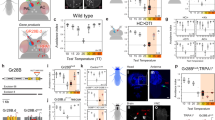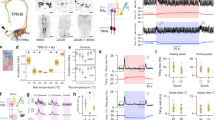Abstract
Small insects regulate their body temperature solely through behavior. Thus, sensing environmental temperature and implementing an appropriate behavioral strategy can be critical for survival. The fly Drosophila melanogaster prefers 24°C, avoiding higher and lower temperatures when tested on a temperature gradient. Furthermore, temperatures above 24°C have negative reinforcing properties. In contrast, we found that flies have a preference in operant learning experiments for a low-temperature-associated position rather than the 24°C alternative in the heat-box. Two additional differences between high- and low-temperature reinforcement, i.e., temperatures above and below 24°C, were found. Temperatures equally above and below 24°C did not reinforce equally and only high temperatures supported increased memory performance with reversal conditioning. Finally, low- and high-temperature reinforced memories are similarly sensitive to two genetic mutations. Together these results indicate the qualitative meaning of temperatures below 24°C depends on the dynamics of the temperatures encountered and that the reinforcing effects of these temperatures depend on at least some common genetic components. Conceptualizing these results using the Wolf–Heisenberg model of operant conditioning, we propose the maximum difference in experienced temperatures determines the magnitude of the reinforcement input to a conditioning circuit.








Similar content being viewed by others
References
Bausenwein B, Wolf R, Heisenberg M (1986) Genetic dissection of optomotor behavior in Drosophila melanogaster. Studies on wild-type and the mutant optomotor-blind H31. J Neurogenet 3:87–109
Bitterman ME (1975) The comparative analysis of learning. Science 188:699–709
Collett TS, Collett M (2004) How do insects represent familiar terrain? J Physiol Paris 98:259–264
Diegelmann S, Zars M, Zars T (2006) Genetic dissociation of acquisition and memory strength in the heat-box spatial learning paradigm in Drosophila. Learn Mem 13:72–83
Dura JM, Preat T, Tully T (1993) Identification of linotte, a new gene affecting learning and memory in Drosophila melanogaster. J Neurogenet 9:1–14
Guo A, Li L, Xia SZ, Feng CH, Wolf R, Heisenberg M (1996) Conditioned visual flight orientation in Drosophila: dependence on age, practice, and diet. Learn Mem 3:49–59
Harlow HF (1959) The formation of learning sets. Psychol Rev 56:51–65
Heisenberg M, Wolf R, Brembs B (2001) Flexibility in a single behavioral variable of Drosophila. Learn Mem 8:1–10
Levin LR, Han PL, Hwang PM, Feinstein PG, Davis RL, Reed RR (1992) The Drosophila learning and memory gene rutabaga encodes a Ca2+/Calmodulin-responsive adenylyl cyclase. Cell 68:479–489
Liu L, Yermolaieva O, Johnson WA, Abboud FM, Welsh MJ (2003) Identification and function of thermosensory neurons in Drosophila larvae. Nat Neurosci 6:267–273
Liu G, Seiler H, Wen A, Zars T, Ito K, Wolf R, Heisenberg M, Liu L (2006) Distinct memory traces for two parameters of visual pattern recognition in the Drosophila brain. Nature 439:551–556
Menzel R, Greggers U, Smith A, Berger S, Brandt R, Brunke S, Bundrock G, Hulse S, Plumpe T, Schaupp F, Schuttler E, Stach S, Stindt J, Stollhoff N, Watzl S (2005) Honey bees navigate according to a map-like spatial memory. Proc Natl Acad Sci USA 102:3040–3045
Morris RG (1984) Developments of a water-maze procedure for studying spatial learning in the rat. J Neurosci Meth 11:47–60
Putz G, Heisenberg M (2002) Memories in Drosophila heat-box learning. Learn Mem 9:349–359
Rosenzweig M, Brennan KM, Tayler TD, Phelps PO, Patapoutian A, Garrity PA (2005) The Drosophila ortholog of vertebrate TRPA1 regulates thermotaxis. Genes Dev 19:419–424
Sayeed O, Benzer S (1996) Behavioral genetics of thermosensation and hygrosensation in Drosophila. Proc Natl Acad Sci USA 93:6079–6084
Strauss R, Pichler J (1998) Persistence of orientation toward a temporarily invisible landmark in Drosophila melanogaster. J Comp Physiol [A] 182:411–423
Tracey WD, Wilson RI, Laurent G, Benzer S (2003) painless, a Drosophila gene essential for nociception. Cell 113:261–273
Wolf R, Heisenberg M (1991) Basic organization of operant behavior as revealed in Drosophila flight orientation. J Comp Physiol [A] 169:699–705
Wustmann G, Heisenberg M (1997) Behavioral manipulation of retrieval in a spatial memory task for Drosophila melanogaster. Learn Mem 4:328–336
Zars T (2001) Two thermosensors in Drosophila have different behavioral functions. J Comp Physiol [A] 187:235–242
Zars T (2003) Hot and cold in Drosophila larvae. Trends Neurosci 26:575–577
Zars T, Wolf R, Davis R, Heisenberg M (2000) Tissue-specific expression of a type I adenylyl cyclase rescues the rutabaga mutant memory defect: In search of the engram. Learn Mem 7:18–31
Acknowledgements
We thank Giselle Carmichael and Jan Judy-March for excellent technical assistance. Dr. Andreas Keller kindly provided critical comments to a previous version of the manuscript. This research was supported by the University of Missouri-Columbia and a University of Missouri System Research Board Grant. The experiments described comply with the ‘Principles of animal care’, publication No. 86-23, revised 1985 of the National Institute of Health, and with the current laws of the country in which the experiments were performed.
Author information
Authors and Affiliations
Corresponding author
Rights and permissions
About this article
Cite this article
Zars, M., Zars, T. High and low temperatures have unequal reinforcing properties in Drosophila spatial learning. J Comp Physiol A 192, 727–735 (2006). https://doi.org/10.1007/s00359-006-0109-6
Received:
Revised:
Accepted:
Published:
Issue Date:
DOI: https://doi.org/10.1007/s00359-006-0109-6




